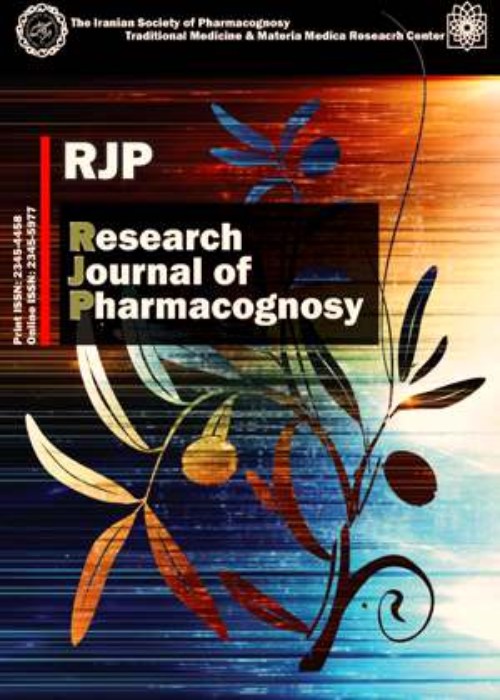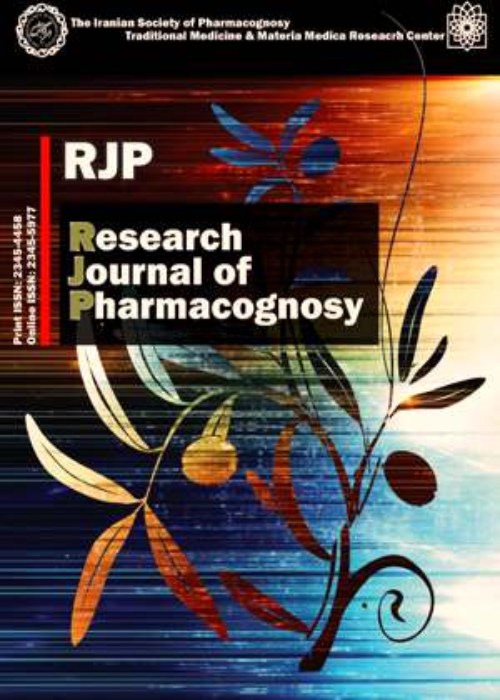فهرست مطالب

Research Journal of Pharmacognosy
Volume:10 Issue: 3, Summer 2023
- تاریخ انتشار: 1402/04/15
- تعداد عناوین: 8
-
-
Pages 1-4Background and objectives
Earlier researches have exhibited the antioxidant, antinociceptive, and antiepileptic effects of Ferula gummosa. Considering that antioxidants play a key role in the pathogenesis of depression, the antidepressant potential of the F. gummosa essential oil was assessed by using a mouse models.
MethodsLorke’s method was used to access the acute toxicity of the F. gummosa essential oil. The F. gummosa essential oil (5-40 mg/kg), standard agents, and vehicle were administered to animals. The forced-swimming test (FST), tail suspension test (TST), and open-field test (OFT) were used for the evaluation of depression.
ResultsThe F. gummosa essential oil LD50 was found to be 316.22 mg/Kg b.w. β-Pinene, α-pinene, guaiol, δ-3-carene, bulnesol, α-Bisabolol, and β-myrcene were the major components of the F. gummosa essential oil, respectively. In both FST and TST, 10-40 mg/kg of the essential oil decreased the duration of immobility. Furthermore, 10-40mg/kg of the F. gummosa essential oil enhanced the duration of swimming with no significant effect on the duration of climbing in FST. The F. gummosa essential oil did not change the animal locomotion in the OFT.
ConclusionAccording to the results, the F. gummosa essential oil showed antidepressant activity similar to fluoxetine which may have a potential clinical value for the treatment of depression.
Keywords: antidepressive agents, essential oil, Ferula gummosa, mice, monotrepens -
Pages 5-13Background and objectives
Cisplatin is an effective anticancer drug which has some side effects such as acute kidney injury. Myrtenol, a monoterpene alcohol which is found in some plants, has various pharmacological effects including anti-inflammatory and antioxidant activities. In this study, we evaluated the nephroprotective effects of myrtenol in acute kidney injury induced by cisplatin in male mice.
MethodsIn this experimental in-vivo study, 35 male mice were randomly separated into 5 groups, including control, CIS (20 mg/kg cisplatin, intraperitoneally on day 1), dimethyl sulfoxide (DMSO; received cisplatin only on day 1, plus DMSO 1% on the first day, continued for 3 days), and treatment groups (received cisplatin only on day 1, plus myrtenol 25 mg/kg and 50 mg/kg intraperitoneally on the first day, continued for 3 days). The blood urea nitrogen (BUN) levels were evaluated in serum. The renal tissues were collected for evaluating malondialdehyde (MDA), superoxide dismutase (SOD), and catalase (CAT) activities; histopathological investigation was also performed.
ResultsOur results showed that cisplatin administration caused significant elevation in the levels of renal MDA and serum BUN; in contrast, renal SOD and CAT activities significantly reduced. Myrtenol treatment, especially 50 mg/kg for four consecutive days mitigated these alternations in serum and renal tissue. Also, the kidney’s histopathological investigations were consistent with biochemical and oxidative parameters.
ConclusionThe results of our study revealed that myrtenol ameliorates acute kidney injury induced by cisplatin via oxidative stress suppression.
Keywords: cisplatin, kidney, myrtenol, oxidative stress -
Pages 15-23Background and objectives
Vitex doniana Sweet (Lamiaceae) is used to treat various ailments, including respiratory infections, liver diseases, anaemia and jaundice. This study assessed the in vitro antioxidant and membrane stabilization potential, as well as the protective impact of semi-purified solvent fractions of V. doniana leaves against Plasmodium berghei-passaged mice.
MethodsDried leaves were extracted with ethanol, followed by fractionation using a solvent-gradient system of increasing polarity (hexane, ethyl acetate, and methanol), and the concentrated fractions were obtained. Forty-two mice were randomly divided into seven groups as: group 1 (normal control), group 2 (disease control, untreated), while groups 3 to 7 received the standard drugs (artequick and chloroquine) and combined V. doniana fraction (VDF, 100 mg/kg) at varying ratios.
ResultsComparatively to V. doniana extract, the fractions (F6, F8) displayed considerable antioxidant activity by scavenging O2•–, OH• and DPPH radicals, and effectively reduced Fe3+ to Fe2+. VDF (1:1) at different concentrations (200, 400, 600 μg/mL) inhibited erythrocyte haemolysis by 91.29±3.61%, 80.52±0.13%, 75.68±1.45% and 80.57±0.94%, respectively. Also, the VDF in synergy with artequick and chloroquine decreased parasitaemia levels by 4.25±0.25% and 4.65±0.28% compared to the disease control (7.93±1.61%). The combined fractions significantly normalized the plasma calcium concentration (1.85±0.17 mg/dL, 1.65±0.21 mg/dL, 1.72±0.23 mg/dL, 1.65±0.22 mg/dL) for groups 3 to 6 compared to the disease control (1.30±0.09 mg/dL), while the bodyweights presented no significant change in all experimental groups.
ConclusionThe results indicate the promising potential of V. doniana as a drug candidate in managing malarial infection.
Keywords: antioxidant, membrane stability, mice, Plasmodium berghei, Vitex doniana -
Pages 25-30Background and objectives
Radix Scropholaria is dried root Scrophularia ningpoensis Hemsl. which is used uses as a drug against several diseases. In the present study, the crucial affected proteins of rat liver in the presence of radix Scrophularia has been investigated.
MethodsThe differentially expressed proteins (DEPs) were downloaded from literature. The significant DEPs plus 100 added first neighbors were determined and included in “protein query” of STRING database via Cytoscape software. The network was analyzed and the central nodes among the queried DEPs were identified. The 10 first neighbors of the central DEPs were determined.
ResultsRT1-CE12, Gfer, Serpina3c, Rab13, Rbm14, Ighg Psmb8, COX2, Olr796, Mga, Ugt1a6, Ugt2b, Ebpl, Ugt2b, Igf2r, and Amacr as significant DEPs were analyzed via protein-protein interaction (PPI) network analysis, Ugt1a1 and Ugt2b the two up-regulated proteins were highlighted as the crucial proteins in response to the radix Scrophularia.
ConclusionTwo members of UDP glucuronosyltransferase family; Ugt1a1 and Ugt2b, were pointed as the critical liver enzyme which are dysregulated under effect of radix Scrophulariae. Due to crucial role of Ugt1a1 in the liver function, it is suggested that consumption of Scrophularia ningpoensis Hemsl. as a traditional medicine required more investigation.
Keywords: liver, network, protein, rat, Scrophularia -
Pages 31-41Background and objectives
Bioactive compounds derived from plants have been used to treat various ailments with minimal adverse effects effects. The in-silico methods are developed to predict the behavior of drug candidates before performing the in-vitro and in-vivo experiments. In the current study, a computational investigation was conducted to understand the probable mechanisms of two benzoquinone diterpenoids namely fruticulin-A and demethylfruticulin-A isolated from several salvia species by molecular docking and dynamic simulation approaches.
MethodsThe above mentioned compounds with proven anticancer activity were docked against five selected target proteins that regulate cell proliferation and apoptosis including cyclin-dependent protein kinase 2 (CDK-2), CDK-6, DNA topoisomerases I (topo I), topo II and B-cell lymphoma-2 (Bcl-2) using autodock 4.2. Besides, molecular dynamics simulations were applied to evaluate the stability of the best-docked complexes.
ResultsBoth compounds demonstrated remarkable binding affinity to CDK-2 than the known CDK-2 inhibitor. The trajectory analysis for 50 nanosecond (ns) revealed acceptable RMSD, RMSF and Rg values during the entire molecular dynamic simulation which confirmed the stability of complexes.
ConclusionThe results of our study displayed that fruticulin-A and demethylfruticulin-A can be developed as excellent natural product derived CDK-2 inhibitors, and further biological experiments should be performed to confirm their use as an efficient option for treating cancer disease.
Keywords: anticancer, demethylfruticulin-A, fruticulin-A, molecular docking, molecular dynamics -
Pages 43-59Background and objectives
Breast cancer is the most frequently reported malignancy in women worldwide and is a heterogeneous disease. Due to different levels of human epidermal growth factor receptor 2 (HER-2) and its critical role in tumor progression, HER-2 has been considered as a validated target in breast cancer therapy. The present study aimed to identify new and effective HER-2 inhibitors from selected plant-based compounds using a computational drug discovery approach. The anticancer effects of top-ranked compounds were then evaluated using cellular and molecular methods.
MethodsThe binding affinities of 47 herbal compounds (including 21 flavonoids, 16 anthraquinones, and 10 cinnamic acids) with the extracellular domain of HER-2 were evaluated using molecular docking analysis. The top hits were evaluated for their cell proliferation inhibition, apoptosis, and migration effects in high and low HER-2-overexpressing SKBR-3 and MCF-7 cell lines, respectively.
ResultsChrysin, chrysophanol, and chlorogenic acid revealed the highest binding affinity to the extracellular domain of HER-2; therefore, they were considered the top-ranked HER-2 inhibitors in this study. Each component inhibited cell proliferation and decreased migration activity of SKBR-3 and MCF-7 cell lines, while the SKBR-3 cells were affected more. The results of the apoptosis assay showed that chrysin was the only compound that could cause a significant induction of SKBR-3 cell apoptosis in comparison to MCF-7 cells.
ConclusionThe results of the present study suggest that chrysophanol, chlorogenic acid, and especially chrysin may have anticancer effects and could be considered drug candidates for therapeutic aims in human HER-2 positive cancer.
Keywords: breast cancer, epidermal growth factor receptor 2, molecular docking -
Pages 61-75Background and objectives
In India, peptic ulcer is most prevalent gastrointestinal disease. Historically Piper betle has been used to treat stomach problems. In order to identify the phytochemicals present in Piper betle. L. var magahi LC/MS spectroscopic analysis was performed, following which, potential phytomolecules with H+/K+-ATPase inhibitory activity were chosen using in-silico evaluation.
MethodsPhytochemicals in ‘Magahi pan” were investigated and potential H+/K+-ATPase inhibitor phytochemicals that were screened through in-silico analysis and ADME profile of selected phytochemicals were evaluated. Phytochemical characterization was done with the help of LC/MS followed by molecular docking against enzyme H+/K+-ATPase (PDBID:5YLV) using Autodock4.2 and Swiss ADME. The binding affinity, free energy, physicochemical property, saturation of carbon atoms, number of hydrogen bond acceptors-donors, molar refractivity, lipophilicity, water solubility, and drug likeliness property were evaluated in-silico for their predicted bioactivity against H+/K+-ATPase.
ResultsA total of 67 phytoconstituents were identified through LC/MS positive and negative ionization mode spectral analysis and six were selected on the basis of binding energy. Molecular docking results revealed that the isolated compounds interacted with target protein H+/K+-ATPase with minimum binding energy ranging from (1) netilmicin (-9.29 kcal/mol); (2) benztropine (-9.07 kcal/mol); (3) 5,6,7,3’,4’ pentahydroxyisoflavone (-8.45 kcal/mol); (4) 2-O-acetylpseudolycorine (-8.02 kcal/mol); (5) R-95913 (-7.73 kcal/mol) and (6) luteolin (-6.93 kcal/mol), respectively.
ConclusionThe ADME profile analysis and docking studies revealed 5,6,7,3’,4’ pentahydroxy-isoflavone and luteolin as potential molecules for inhibiting H+/K+-ATPase.
Keywords: H+, K+-ATPase inhibitors, Magahi pan, molecular docking, peptic ulcer, Piper betle -
Pages 77-89
Medicinal fruits as adjunct therapy are promising for acute and chronic diseases. However, the role of these fruits remains largely unexplored. This study reviewed the evidence-based efficacy of these fruits used by indigenous people in the Philippines. Indigenous knowledge on using medicinal fruits was searched in the Philippine Traditional Knowledge Digital Health Library database. Medical research databases [Medline, Scopus, GreenFILE, ProQuest, HERDIN, and JSTOR] were queried from inception to April 2022. Searches were in English and Filipino language publications. A narrative synthesis was conducted and 30 articles from the Philippine Traditional Knowledge Digital Health Library database identified the medicinal fruits used among indigenous people in the Philippines. Moreover, 40 articles that included 17 experimental research, 20 reviews, and 3 published reports pointed to the evidence-based effectiveness of these fruits. According to this review, the medicinal fruits included were scientifically evaluated for their medicinal properties, including their anti-oxidant and phytochemical attributes. However, the scientific evidence from previous literature indicated that most experiments constituted in vitro and animal models. Traditional medicine and scientific evidence revealed the protective effects of these fruits against various ailments. Since there were not many human intervention trials available, researchers can study the potential health effects of these therapeutic fruits by using human models in the future. Due to the various health benefits of these indigenous fruits, it is essential to explore their disease-fighting capabilities and convert them into nutraceuticals or functional food ingredients.
Keywords: ethnobotany, indigenous knowledge systems, nutraceuticals, Philippines, prevention of disease


